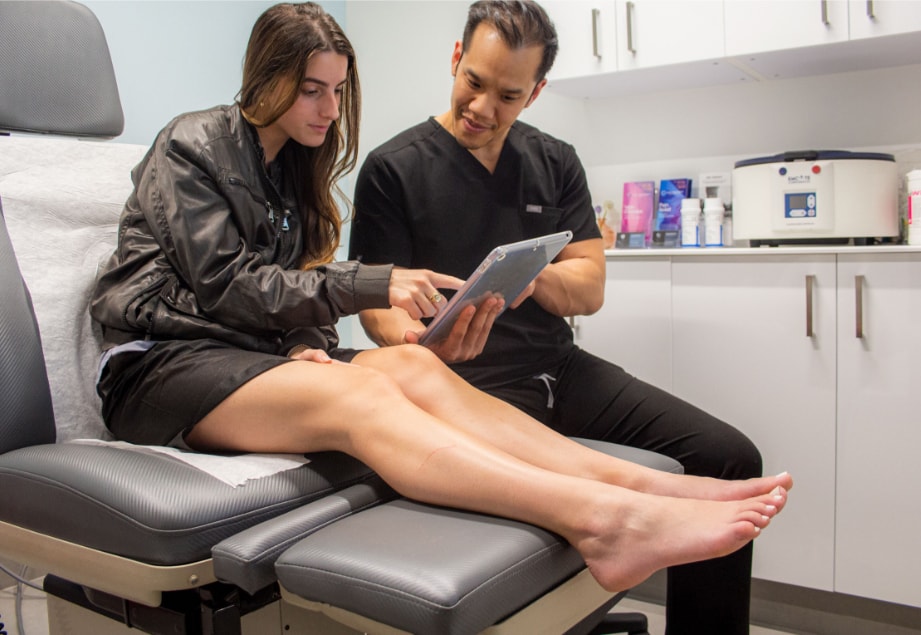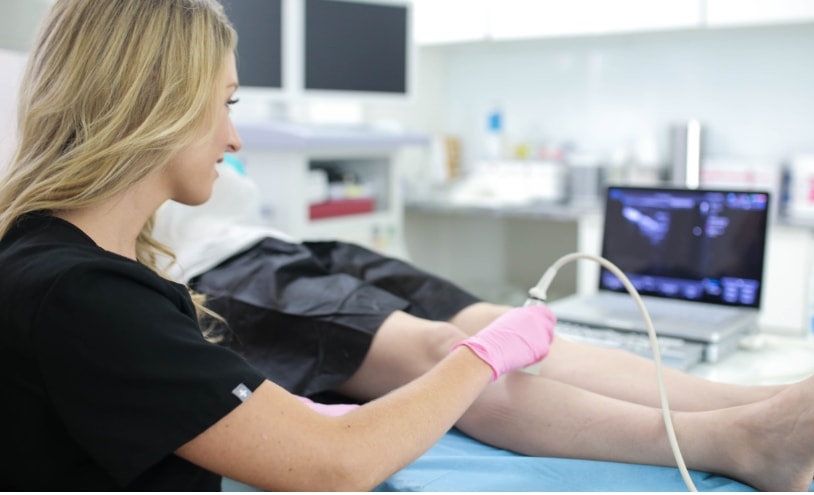Do spider veins go away?
Do spider veins go away? That’s one of the most common questions we receive at our spider vein and varicose vein treatment clinics. When patients ask that question, they generally wonder if spider veins can go away naturally or with home remedies, such as compression stockings and exercise.
The answer to that question is simple — no.
Spider veins can’t go away naturally, nor can they go away because of simple home remedies. In fact, spider veins are broken capillaries on legs and damaged blood vessels that continue spreading with time. If left untreated, the red veins on your legs will continue spreading outwards, expanding more and more.

To understand why spider veins don’t go away naturally, you must understand how spider veins develop.
The Vein Treatment Clinic provides the latest, safest spider vein removal techniques, such as sclerotherapy spider vein treatment. If you have spider veins and varicose veins, please schedule an appointment at our vein treatment centers — we diagnose and treat the root cause of spider veins, ensuring safe and long-lasting results.
Understanding the root cause of spider and varicose veins
Spider veins are essentially damaged blood vessels with an excessive accumulation of blood in leg veins. They’re dense clusters of reddish, bluish, or purple blood vessels or broken capillaries on legs. They derive the name “spider veins” from their appearance — patients say they look like a dense mass of spider webs or the legs of spiders.

Chronic venous insufficiency is the root cause of most vein problems, including varicose veins, veins popping out on the legs, and spider veins. Venous insufficiency is a medical condition wherein the collapse of vein valves leads to the accumulation of blood in leg veins, which, in turn, leads to vascular dilation and the formation of spider veins.
Spider veins and varicose veins occur because of excess blood accumulation in leg veins, which is a direct consequence of underlying vein disease. As such, spider veins aren’t simple cosmetic problems that can fade away with time — they’re indicative of a deeper and more serious problem with several long-term complications.
Why spider veins don’t go away naturally
Spider veins don’t go away naturally because they’re caused by a chronic medical condition known as venous insufficiency. The spider veins are essentially damaged blood vessels and the pathways caused by broken capillaries on legs. They remain under the skin’s surface, visible just between the epidermis and dermis layers of the skin.
As long as you have underlying vein disease, blood will continue accumulating in the leg veins. The more that blood accumulates in leg veins, the more prominent your spider veins will become. Over time, spider veins will continue spreading outwards, and you may also develop veins popping out on the legs, also known as varicose veins,
As such, far from going away naturally, spider veins and varicose veins worsen with time.
Some lifestyle changes can alleviate spider veins
Spider veins can’t go away naturally, but some lifestyle changes may alleviate the superficial symptoms of vein disease. If you want to temporarily minimize the appearance of spider veins or prevent them from spreading, you should engage in activities that promote blood circulation. Your goal is to push the accumulated blood from your leg veins to your heart.
The following are possible lifestyle changes to promote healthy blood circulation and prevent spider veins and varicose veins from spreading further:
- Wear compression stockings to promote blood flow to the heart
- Engage in cardiovascular exercises that engage your calf muscles, such as running
- Elevate your legs while sitting down
- Take regular walking breaks, and avoid sitting down for long periods
Please note that the aforementioned lifestyle changes can only alleviate the symptoms of vein disease — they can’t treat chronic venous insufficiency. You might notice mild improvements in your spider veins, but the results will be temporary. Your spider veins will return once you stop wearing compression stockings. The only way to remove spider veins permanently is to undergo minimally invasive spider vein and varicose vein treatments.
Spider vein removal with sclerotherapy promises stellar results
The Spider Vein and Varicose Vein Treatment Clinic follows a comprehensive approach to vein treatments. We understand that spider veins are usually symptomatic of underlying venous insufficiency. That’s why we don’t immediately recommend treatments — we assess and identify the root cause of vein disease before curating a personalized treatment plan.
During your appointment, the vein doctor will examine your leg veins, review your medical history, discuss your symptoms, and administer ultrasound diagnostic tests to visualize and identify the root cause of spider veins. After identifying the root cause, the vein doctor curates a personalized vein treatment plan just for you.
If you have chronic venous insufficiency, your vein treatment may include radiofrequency ablation, laser ablation, venaseal, or clarivein. These procedures involve using thermal energy, laser energy, mechanical energy, or medical adhesives to collapse and destroy the diseased saphenous vein responsible for your vein problems, thus rerouting accumulated blood into healthier veins.
Once the underlying vein disease has been addressed, the vein doctor can proceed with spider vein removal. Treating spider veins without addressing the root cause would inevitably cause a relapse. Sclerotherapy is widely considered the best spider vein treatment. The vein doctor injects a sclerosant medicine into spider veins to make them shrink and harden into scar tissues eventually metabolized by the body.
Sclerotherapy is a simple, in-office treatment that concludes within 30 minutes, following which you can resume your daily activities and work. Spider vein removal with sclerotherapy is the most effective means of removing unwanted spider veins on the legs. Each injection removes one spider vein, so you may need additional treatments for all spider veins.









